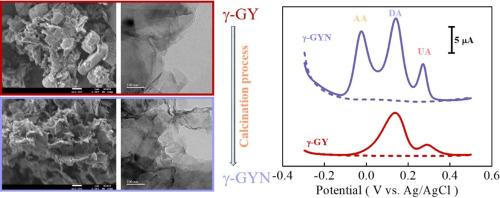Effect of calcination temperatures on γ-graphyne for simultaneous electrochemical detection of dopamine, uric acid, and ascorbic acid
IF 5.1
3区 材料科学
Q2 MATERIALS SCIENCE, COATINGS & FILMS
引用次数: 0
Abstract
Given the increasing public concern over health-related issues, multiplexed detection of biomarkers has become essential in biomedical diagnostics. In this study, we developed a novel electrochemical sensor based on calcined γ-graphyne (γ-GYN). The material was synthesized by first preparing γ-graphyne (γ-GY) through an ultrasonic sonochemical method and subsequently calcined at various temperatures to obtain γ-GYN. The calcination process introduces structural imperfections and open edges, transforming γ-graphyne (γ-GY) into a more defect-rich γ-GYN with enhanced electrochemical properties. This modified structure facilitates the simultaneous electrochemical detection of ascorbic acid (AA), dopamine (DA), and uric acid (UA).
The physicochemical properties of γ-GY and γ-GYN materials were systematically characterized using scanning electron microscopy (SEM), Raman spectroscopy, and X-ray photoelectron spectroscopy (XPS). Electrochemical performance was evaluated through cyclic voltammetry (CV) and differential pulse voltammetry (DPV). The γ-GYN modified electrodes demonstrated outstanding sensing performance due to their optimized structural characteristics, featuring a loosely stacked layered structure and increased exposure of active sites. The sensor enabled simultaneous detection of AA, DA, and UA with linear ranges of 200–1000, 0.6–2.0, and 10–1000 μM, respectively. The corresponding detection limits were 36.87 μM for AA, 0.09 μM for DA, and 0.85 μM for UA, with sensitivities of 0.68, 220.49, and 12.77 μA μM−1 cm−2, respectively. These findings not only confirm the excellent performance of γ-GYN-based materials but also establish γ-GYN as a promising platform for electrochemical multi-analyte detection. The integration of γ-GYN into such detection systems opens a new pathway for developing diagnostic tools that are low-cost, portable, and highly sensitive, thereby improving healthcare delivery and reducing healthcare costs associated with managing community health conditions.

焙烧温度对γ-石墨炔同时电化学检测多巴胺、尿酸和抗坏血酸的影响
鉴于公众对健康相关问题的日益关注,生物标志物的多重检测在生物医学诊断中变得至关重要。在这项研究中,我们开发了一种基于煅烧γ-石墨炔(γ-GYN)的新型电化学传感器。该材料首先通过超声声化学方法制备γ-石墨炔(γ-GY),然后在不同温度下煅烧得到γ-GYN。煅烧过程引入了结构缺陷和开放边缘,将γ-石墨炔(γ-GY)转化为缺陷更丰富的γ-GYN,具有增强的电化学性能。这种修饰的结构有助于同时电化学检测抗坏血酸(AA)、多巴胺(DA)和尿酸(UA)。利用扫描电镜(SEM)、拉曼光谱(Raman spectroscopy)和x射线光电子能谱(XPS)对γ-GY和γ-GYN材料的物理化学性质进行了系统表征。通过循环伏安法(CV)和差分脉冲伏安法(DPV)评价其电化学性能。γ-GYN修饰电极由于其优化的结构特征,具有松散堆叠的层状结构和增加的活性位点暴露,表现出出色的传感性能。该传感器可同时检测AA、DA和UA,线性范围分别为200 ~ 1000 μM、0.6 ~ 2.0 μM和10 ~ 1000 μM。AA、DA和UA的检出限分别为36.87 μM、0.09 μM和0.85 μM,灵敏度分别为0.68、220.49和12.77 μA μM−1 cm−2。这些发现不仅证实了γ-GYN基材料的优异性能,也奠定了γ-GYN作为电化学多分析物检测平台的良好前景。将γ-GYN集成到此类检测系统中,为开发低成本、便携和高灵敏度的诊断工具开辟了一条新途径,从而改善医疗保健服务,降低与管理社区卫生状况相关的医疗保健成本。
本文章由计算机程序翻译,如有差异,请以英文原文为准。
求助全文
约1分钟内获得全文
求助全文
来源期刊

Diamond and Related Materials
工程技术-材料科学:综合
CiteScore
6.00
自引率
14.60%
发文量
702
审稿时长
2.1 months
期刊介绍:
DRM is a leading international journal that publishes new fundamental and applied research on all forms of diamond, the integration of diamond with other advanced materials and development of technologies exploiting diamond. The synthesis, characterization and processing of single crystal diamond, polycrystalline films, nanodiamond powders and heterostructures with other advanced materials are encouraged topics for technical and review articles. In addition to diamond, the journal publishes manuscripts on the synthesis, characterization and application of other related materials including diamond-like carbons, carbon nanotubes, graphene, and boron and carbon nitrides. Articles are sought on the chemical functionalization of diamond and related materials as well as their use in electrochemistry, energy storage and conversion, chemical and biological sensing, imaging, thermal management, photonic and quantum applications, electron emission and electronic devices.
The International Conference on Diamond and Carbon Materials has evolved into the largest and most well attended forum in the field of diamond, providing a forum to showcase the latest results in the science and technology of diamond and other carbon materials such as carbon nanotubes, graphene, and diamond-like carbon. Run annually in association with Diamond and Related Materials the conference provides junior and established researchers the opportunity to exchange the latest results ranging from fundamental physical and chemical concepts to applied research focusing on the next generation carbon-based devices.
 求助内容:
求助内容: 应助结果提醒方式:
应助结果提醒方式:


